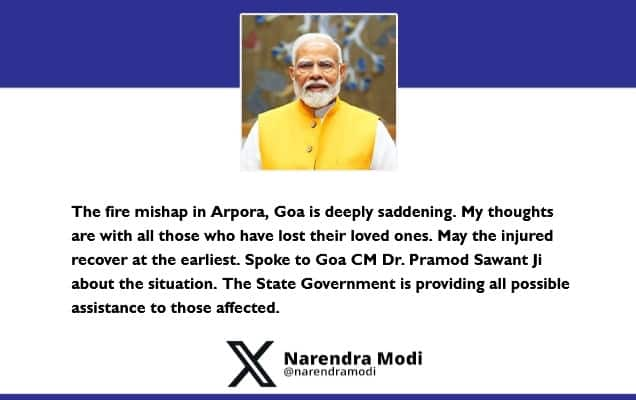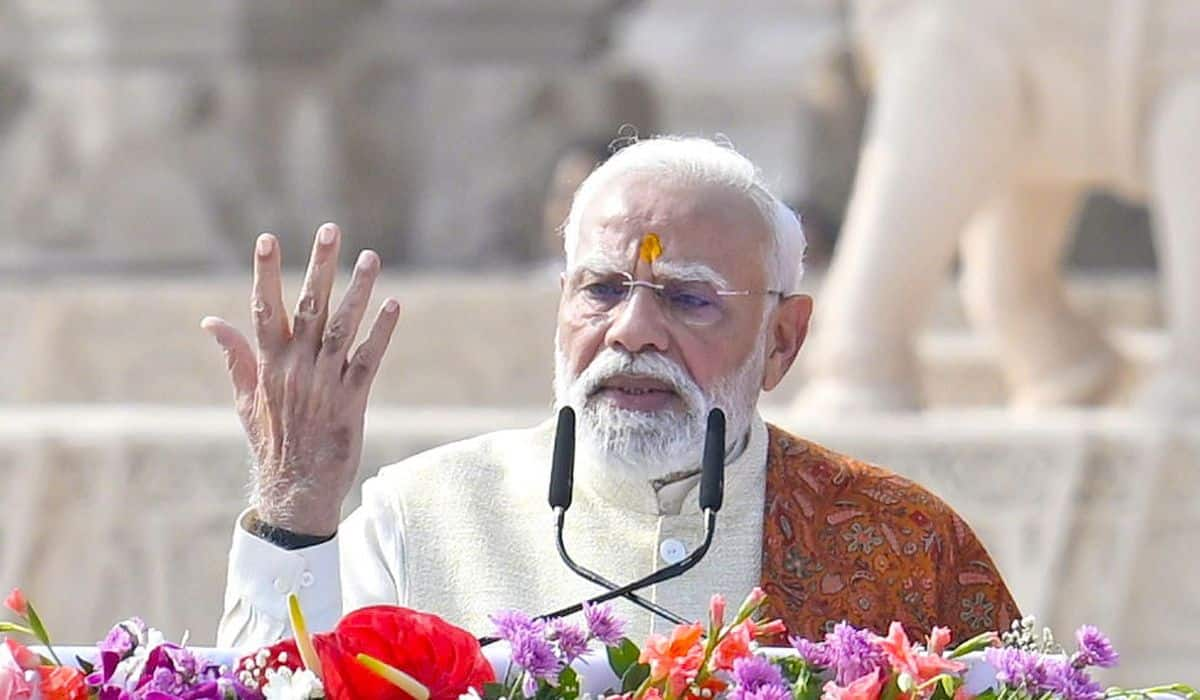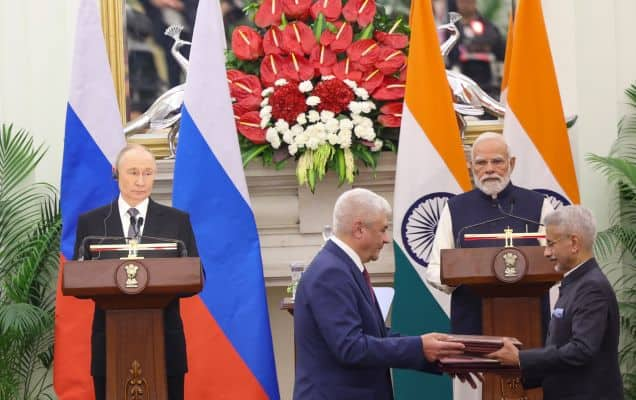Shakyaji, you, your colleagues and Kathmandu's municipal corporation have organized this reception for me. I am extremely grateful to you people for this thing. It is not only for me, but it is an honor to entire India. Not only me, but 1.25 billion Indians are also grateful. Every Indian has a relationship of affinity with Kathmandu and Nepal. And I am also fortunate to have got this thing.
Even when I was not in politics… Whenever I visit Nepal, I have this feeling of peace and affection. And the biggest reason for this is your love, your affection and the warm welcome and respect shown by you people.
Yesterday, I was in Janakpur. It gives a very important message to the modern world. What was the uniqueness of Raja Janak? He caused the destruction of weapon and joined all with love and affection. This is the land that destroys the weapons and binds with love and affection.
Friends, whenever I think of Kathmandu then the image that emerges is not just of a city. That image is not of just a geographical valley. It’s not just that Kathmandu is mere capital of our neighbor and inseparable friend Nepal. It is not only the capital of the country of Mt. Everest and Lily Guraj. It is not only the capital of the country of Lord Buddha's birthplace. Kathmandu is a world in itself and the history of this world is as old, as majestic and as vast as the Himalayas.

Kathmandu has always attracted me. Because this city is as deep as it is fast moving. It is a precious jewel in the lap of the Himalayas. Kathmandu, is not just a canopy made of wood. This is a divine and grand palace of our shared culture and heritage. The city's diversity gives a glimpse of Nepal's great heritage and its large heart. Whether it is the forest of Nagarjuna or the hills of Shivpuri, whether it is calmness of hundreds of waterfalls and streams or the origins of Baghmati, this city of thousands of temples, Manjushree caves and Buddhist monasteries is unique in the world in itself.
From the roof of the buildings here one can see Dhaulagiri and Annapurna on one side and Sagarmatha on the other side which are known to the world as Everest and Kanchan Jangha. Where else this kind of view is possible? And if it is possible then it’s only and only in Kathmandu.
The patterns of Basantpur, the reputation of Patan, the magnificence of Bharatpur, the art of Keertipur and the elegance of Lalitpur; it seems Kathmandu has gathered all the colors of a rainbow in itself. So many traditions are mixed in its air just as Roli mixes with sandalwood. Prayers at Pashupatinath; gathering of devotees; spirituality walking on the stairs of the Sovereign Lord; chanting of 'Om Mani Padme Hum' echoing at the every step taken by the pilgrims performing parikrma of Lord Buddha. It seems as if all the musical notes of a tune have embraced each other on the threads.
I have been told that certain festivals, such as the festivals of Nevari community, are such that have an unprecedented confluence of Buddhists and Hindu beliefs and practices. Tradition and culture have made the artisans and handicraft of Kathmandu unmatched. Whether it is handmade paper or statues like Tara and Buddha; whether it is utensils made of clay from Bharatpur or stone, wood and metal work of Patan, Kathmandu is the great amalgamation of Nepal's unique art and craftsmanship. And I am glad that the new generation of Nepal have been following very well this tradition. And it is also bringing a newness to it by modifying it as per the youth.

Friends, I have had the privilege of visiting Pashupatinath in both of my visits to Nepal so far. In this visit, I was fortunate to visit Janakpur Dham and Muktinath in addition to Pashupati Nath, to all the three holy shrines. These three places are not only important pilgrim centers, they are India and Nepal's unshakable and unbreakable relation like Mt. Everest. In future whenever there will be an opportunity for me to visit Nepal, I will certainly make a programme to visit Lord Buddha's birth place Lumbini.
Friends, peace, and balance with nature, and value systems of both of our countries which are filled with spiritual values, these are a legacy for all the mankind and for the entire world. And, therefore, it is not surprising thing that people from all over the world are drawn towards India and Nepal in search of peace.
Some people go to Banaras and some other visit Bodh Gaya, while some go and stay in the lap of the Himalayas, while some other people live like ascetics in the monasteries of Buddha, but the quest is the same. The solution to the malaise of modern life will be found in the shared values of India and Nepal.
Friends, Pashupatinath located on the bank of river Bagmati in Kathmandu and Kashi Vishwanath located on the banks of river Ganges, Buddha's birthplace Lumbini, Bodh Gaya - the place for hermitage, and Sarnath – the region from where the message was delivered.
Friends, we all of us have a rich and common heritage which is thousands of years old. Our shared heritage is the property of youth of both the countries. It has the roots of their past, the seeds of the present and the shoots of their future.
Friends, the entire world is passing through an era of several types of changes. Global environment is full of several fluctuations and uncertainties.
Friends, for thousands of years this belief that the whole world is one family has been the philosophy of India. We have been taking forward our philosophy of Sabka Sath-Sabka Vikas (Together with all, development for all) in our foreign cooperation policy with the same piousness. There is a prayer in Indian scriptures:
सर्वे भवन्तु सुखिन: सर्वे सन्तु निरामया:। सर्वे भद्राणि पश्यन्तु मा कश्चित् दुःख भाग्भवेत्।
Which means: May all be happy, may all be healthy. May there is wellbeing for everyone, may no one suffer. Indian seers have always dreamed of this thing. To achieve this ideal, our foreign policy is based on taking everyone along with us and we particularly share the experiences and opportunities of India with our neighborhood. In our culture ‘Neighborhood First’ is not just foreign policy but it is a way of living. There are many examples. While being a developing country itself, India has been cooperating for more than 50 years for capacity building in more than 160 countries under the Indian Technical and Economic Cooperation Program, and we have been extending our cooperation as per the requirements of those countries.


Last year India launched South Asia satellite. As a result of this, our neighboring countries are receiving its services as a gift from our space capabilities. And when I had come here at the same platform for SAARC Summit then I had announced this thing from the same platform. At the same time, we are also focusing on how we can forge international partnerships to face the major challenges of the modern world which no one country can handle on its own. For example, in 2016, India and France together conceived a new international treaty based organization in the context of climate change. This revolutionary step has now been converted into a successful experiment.
In March this year, French President Macron and the leaders of nearly 50 other countries participated in the first summit of this International Solar Alliance in Delhi. Such efforts will help in forging technological and economic partnerships to meet the challenges of climate change, I am confident that this will particularly help in meeting the needs of small developing countries.
Friends, when Indians look at Nepal then we become very happy to see the environment and people here. The atmosphere in Nepal is full of optimism and of desire to have a bright future, and for strengthening the democracy, and also of the vision of a ‘Prosperous Nepal, Happy Nepalese’, and all of you have contributed in a very big way in creating this environment.
After the massive tragedy of the earthquake of 2015, the patience and indomitable courage exhibited by the people of Nepal and especially in Kathmandu is an example for the entire world. This is a testimony to the firm commitment and hard work of your society that a new system has been created in Nepal in such a short time while handling the disaster. After the earthquake, not just the buildings, in a way the whole country and society were rebuilt. Today there are democratic governments at all the three levels in Nepal - federal, provincial and local. And the elections for all three levels have been successfully conducted within one year. This power is inherent in all of you therefore I sincerely congratulate all of you.
Friends, Nepal has come a long way from the war to Lord Buddha. Bullet was dominant power but Nepal has opted for ballot after giving up bullet. This is journey from the war to Buddha. However, the destination is still far away, you still have to go a long distance. In a way, now we have reached the base camp of Mount Everest, but we still need to climb to the summit of Mt. Everest. And as mountaineers get a very strong support and company from the Sherpas of Nepal, India is ready to do the work of a Sherpa for you people in this developmental journey of Nepal.
This was the message that I have delivered in different words, this was the feeling that I have expressed yesterday and today during my Nepal visit, and also during the Prime Minister Oli’s visit to India last month. I am saying this thing with a lot of responsibility that Nepal must march ahead according to its own needs and priorities. India will always walk shoulder to shoulder with Nepal for its success. India’s success lies in your success. India’s happiness lies in Nepal’s happiness.
Whether it is the work of constructing railway lines or laying roads or the work of hydropower or of transmission lines or of Integrated Check Post or of oil pipeline or whether it is the job of further strengthening the cultural and people to people ties between the people of Nepal and India, we are always with you in your every need and will continue to do so in future also. We have started the work on DPR (detailed project report) for connecting Kathmandu with India through railway. And, now, perhaps it is…I don’t know how much discussion it has received here in Nepal, these days IPL cricket matches are being organsied in India and Nepal has also connected with IPL.
You are familiar with several recent initiatives of this journey. I have been told that for the first time a Nepalese player Sandeep Lamichane has been participating in the IPL. I hope that in future our people-to-people relationship will continue to be strengthened not only through cricket but also through other sports as well.
Friends, with these words, I once again express my heartfelt gratitude to the mayor of Kathmandu Shri Shakya ji, to the administration of Kathmandu, to the Government of Nepal, to the respected chief minister, to the respected foreign minister and to all of you. And I have the same feelings in my heart as you have in your hearts, the same feeling is there in my heart which is there in the heart of every Nepali, and the same feeling is there in the heart of every Indian and that is:
Long Live, Nepal-India Friendship,
Long Live, Nepal-India Friendship,
Long Live, Nepal-India Friendship,
Thanks a lot.
Kathmandu is a special city. It has an important place in the history of the world. pic.twitter.com/moWqTXl9AA
— PMO India (@PMOIndia) May 12, 2018
Kathmandu is a mixture of the ancient and the modern. This city showcases the culture of Nepal. pic.twitter.com/ykNpnctf4j
— PMO India (@PMOIndia) May 12, 2018
There is something unique about the beauty of Kathmandu. pic.twitter.com/c07gPVwGZg
— PMO India (@PMOIndia) May 12, 2018
During my previous visits I prayed at Pashupatinath. This time, in addition to Pashupatinath, I went to Janakpur and Muktinath. These places illustrate close ties between our nations. pic.twitter.com/5L07yXZWeJ
— PMO India (@PMOIndia) May 12, 2018
'Sabka Saath, Sabka Vikas' is as much about global wellbeing as it is about India's growth. pic.twitter.com/FlxBgN7MhZ
— PMO India (@PMOIndia) May 12, 2018
India has always worked for global good. pic.twitter.com/hLY7Y60yUE
— PMO India (@PMOIndia) May 12, 2018
India has taken the lead in mitigating the menace of climate change. The International Solar Alliance has brought together nations from across the world. pic.twitter.com/qgd5Eokp4X
— PMO India (@PMOIndia) May 12, 2018
There is an atmosphere of hope and optimism in Nepal, says PM @narendramodi. pic.twitter.com/IEbLcvWe0O
— PMO India (@PMOIndia) May 12, 2018
Admiring Nepal's spirit of resilience and commitment towards democracy. pic.twitter.com/hgvyJKrFTN
— PMO India (@PMOIndia) May 12, 2018
India stands shoulder to shoulder with Nepal in its development journey. pic.twitter.com/ByJQITwM2T
— PMO India (@PMOIndia) May 12, 2018
Connecting through cricket...more power to people-to-people ties between India and Nepal. pic.twitter.com/V9i2lXHf2p
— PMO India (@PMOIndia) May 12, 2018














